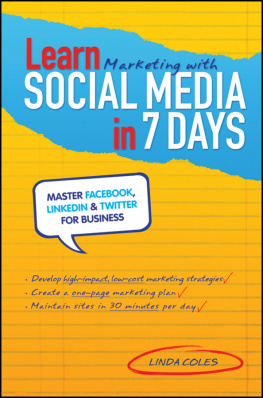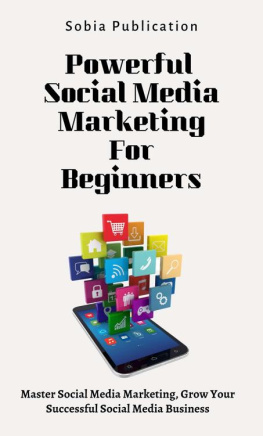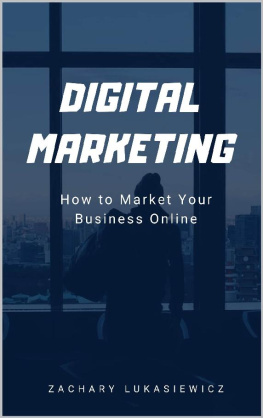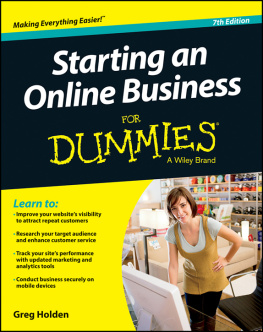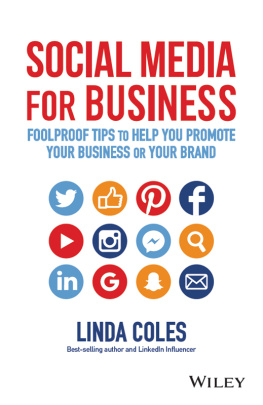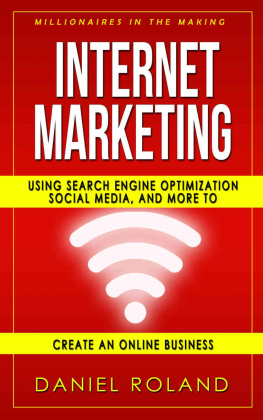Introduction
This is the book we would have liked to have read when we started our businesses. We wrote it to be useful whether you are just thinking of starting a business on the side, or if you have a company thats doing well, but you are ready to launch it to the next level.
As entrepreneurs ourselves (Hannah started her business while working full-time, and Miriam launched hers after leaving her previous job), we both experience the benefits of using social media every day. In this book, we teach you how to demonstrate your expertise, grow your network of potential customers and clients, and learn new things that can make the difference between having a hobby and having a successful, thriving company.
Lucky for all of us, social networks have leveled the playing field:
If you want to be a consultant, coach, or market other services, and you have the expertise, you can create a business and connect with clients online. In the online world, introverts can compete just as well as extroverts; you dont need to be gregarious to display what you know; you just need to have the skills your clients expect.
If you have products to sell, you can learn how to highlight their features, advertise how they can make a difference to customers, and garner a community of friends and fans who will serve as a funnel for customersall from the comfort of your home or office, or on-the-go via mobile devices. (How awesome is that?)
Having your own business is about taking action, trying new things, making mistakes and learning from them, and most importantly, building new connections.
You can do it! Using social media does not require you to be a rocket scientist or a technology specialist. With the right tools and focused expertise that youll learn from our book, youll be able to move ahead with confidence. And, guess what? While this book has a lot of information, we promise we have only included what we think you need to know without the fluff.
So, lets get started. We hope youll agree that using online tools to start or grow your business is an incredible experience. Take some risks, develop a few new skills and have fun. Were glad to be along for the ride!
To your success!
Miriam and Hannah
CHAPTER 1
Why Starting Your Own Business Makes Sense: Times (and the workforce), They Are a-Changin
I n the old days, having a job meant working in one place, often for decades at a time. You probably only searched for a new position if you were unhappy at your current job, or if a better opportunity came along. Today, however, its unusual to find someone loyal to one company for an extended time.
More businesses are hiring contingent workers, otherwise known as temporary or contractors, instead of full-time employees. Tammy Erikson of Harvard Business Review wrote, Temporary placement service provider Adecco predicts the growth rate for contingent workers will be three to four times the growth rate among traditional workforces. Adecco predicts temporary workers will eventually comprise about 25 percent of the global workforce. As a result, finding traditional jobs will continue to be highly competitive. Employers will replace many jobs with contract workers.
These data suggest income security is unlikely to come from working in one organization for the long haul. Instead, many professionals are turning to entrepreneurism as an anecdote to the tough job market; they are creating their own jobs by becoming business owners in their own right.
If youre considering this path, you are not only in good company; youre a smart cookie! For years, futurists have been predicting the end of jobs as we know them, suggesting that, increasingly, companies will turn to independent contractors instead of full-time employees to accomplish key tasks.
When the times are changing, you need to change, too. Whether you are considering launching a full-fledged business, or just want to do a little consulting on the side, consider this a wake-up call to delve into social media for your career or business, if you have not already done so. Knowing how to use these tools will make a huge difference to your success, because using them well will help market your skills, products, and services.
THE NEW INDEPENDENT WORKFORCE
According to the website Mavenlink, the number of self-employed, independent service firms, solopreneurs (independent business owners), and temporary workers grew by an estimated 4.3 million workers between 1995 and 2012. They expect the contingent workforce to grow to 40 percent, or 64.9 million workers by 2020. If these come true, 40 percent of American workers, or nearly 65 million people, will not be working in what we know as traditional jobs by 2020.
The Gig Economy
We used to think of temporary work being the purview of short-term administrative support people, seasonal retail positions, and accountants before tax day. Now, the temporary workforce includes not only people who work for temp agencies, but also those engaging in what has become known as the gig economy. This workforce includes independent contractors, freelancers, and entrepreneurs who hang a literal or virtual shingle, and launch their own small businesses.
Luckily, while the tide is changing in favor of a contingent, or temporary, workforce, there are fewer barriers to starting a business now than ever before. Years ago, you needed to invest money or secure a loan to launch a business. You probably would have rented a brick and mortar office or store, and paid for ads in the Yellow Pages, print journals, and magazines. If you were a service business, you may have limited your clientele to local prospects; a national (or international) audience was beyond the reach of most contractors or small businesses.
Is Having a Business For You?
Maybe youre not sure if business ownership is for you. If you plan and use your time well (and use the information we provide in this book), you can test the waters, and start your business on the side while you keep your full-time job.
Keep in mind: social media and online tools allow you to create side businesses providing multiple streams of revenue. Even if you are not ready to commit to being a full-time business owner, we believe you should begin to envision side revenue streams, no matter how safe you believe your job to be. Think about how to diversify your portfolio of income opportunities. One way to do this is to use social networks to demonstrate your expertise, and create new contacts who can help lead to new income opportunities.
Create a Side HustleBe Someone With MOXIE
In the new economy, having multiple income streams provides a layer of security you cannot expect from an employer. You may see people refer to this moonlighting phenomenon as having a side hustle . We think the term hustle has negative connotations. (One definition is to obtain by aggressive or illicit means.) We want to define and use a new term to describe someone who starts a business on the side while working.
The word moxie refers to someone who has courage, nerve, or vigor. According to Dictionary.com, a non-alcoholic drink named moxie popularized the term because the company touted it as helping people build up nerve. We polled our networks, and everyone agreed moxie conjured up positive connotations, so we thought it would be a great term and acronym for people who are:
M anaging
O ther (secondary)
X -tra
I ncome
E ngagements
In our book, when we refer to a MOXIE, we are talking about someone who is earning income on the side, while still working in a traditional job. Some MOXIEs may want to transition to working in their extra engagements full time at some point, while others just want extra, new income streams.
Dont Let Your MOXIE Gig Interfere With Your Main Job
If you do start a business on the side, be careful not to put your day job in jeopardy. Make sure your employer doesnt have rules against moonlightingyou may have agreed to policies by signing documents when you started your job and not remember it.
Next page



